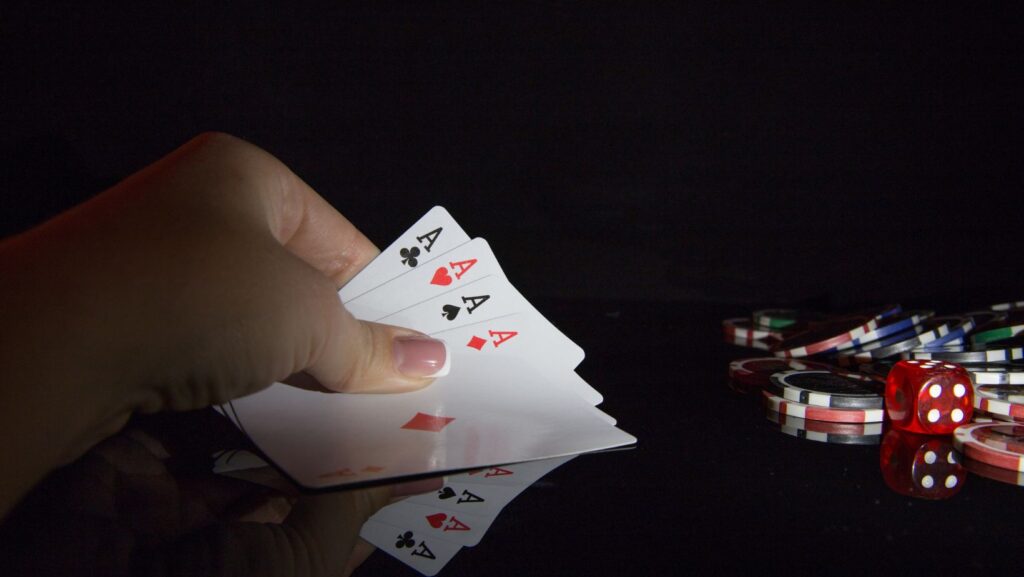Badugi is a unique poker game that relies heavily on bluffing and reading opponents’ hands. As there are only 4 card hands, the number of possible combinations is far fewer compared to games like Texas Hold’em. This allows skilled players to make accurate reads and set up big bluffs. Master these skills, and you’ll be able to dominate any Badugi table at any casino, whether it’s an online venue like Slot Lords Casino or a physical one.
Getting Started with Badugi Rules and Hands
Badugi hand rankings are dramatically different from other poker variants. The goal is to make the lowest 4 card hand possible, using one card of each suit. Straights and flushes don’t count – only the lowest unmatched cards. The best possible hand is A♠ 2♥ 3♦ 4♣.
It’s vital to learn these unique Badugi hand rankings before attempting to analyze opponents’ hands or planning advanced plays. Study the rules and practice identifying hand strengths until you can do it instantly from memory.
Reading Opponents’ Hands
Skilled Badugi players don’t rely on the cards alone. They combine hand reading skills with solid bluffing to keep opponents off balance. Here are some tips to start analyzing players’ hands:

- Watch which cards they draw. This obviously gives clues about their holdings.
- Note reactions to dealt cards and draw rounds. Expressions can reveal hidden strengths or weaknesses.
- Assume indecision means weakness. Strong Badugi hands stand out clearly.
You can never know opponents’ exact cards, but even probabilities and partial information help guide your actions.
Setting Up the Bluff
Armed with hand reading skills, you can now use deception to your advantage. Bluffing relies on selling a false story that compels opponents to fold better hands. Here is an effective bluffing blueprint:
- Establish a strong front early. Bet big after the draw to indicate strength.
- Make your bluff believable. Don’t represent hands impossible given past betting patterns and discards.
- Disguise real hand weaknesses if bluff fails. Throw away a worthless final card so opponents can’t detect a bust.
- Remain consistent in your bluff. Don’t lose confidence halfway through the hand.
Follow these steps, while incorporating physical tells like hesitation or confidence, and you can pull off big bluffs even when dealt poor cards.
Advanced Reads: Isolating Players With Nut Low Draws
Once you have a solid bluffing foundation, you can work on advanced hand reading skills. One effective play is isolating opponents when you predict they’re drawing to nut low hands (the best possible hand).

For example, if an opponent discards three cards on a particular suit, they likely need the final card of that suit to complete an extremely strong hand. Now is the perfect time to target them with isolation raises, building a side pot you can steal if they miss their longshot draw.
Be aware this is a risky play requiring strong reads and opponent awareness. But executed correctly, you can win big pots with well-timed isolation raises versus nut low draws.
Exploiting Passive Players Who Overfold
You must balance reading hands and executing bluffs against different opponent types. Some players overfold compared to perfect game theory strategy. They play too snugly, only continuing with extremely strong hands. This leaks money over the long run.
Against these players, incorporate more light bluffing (bluffing with poor hands). Their overly tight strategy means they’ll frequently fold better hands to your bluffs and semi-bluffs (hands with potential to improve). This creates profitable situations where you risk little to win sizable pots.
Just be sure only to run light bluffs against proven passive opponents, not aggressive players who’ll fight back.
Using Statistical Frequencies to Guide Actions
While hand reading relies on observation and intuition, you can also leverage statistical frequencies to improve decision making. When an opponent discards a certain suit on the draw, for example, you can calculate the probability of them completing a low hand on the next card. Use these percentages to guide bet sizing and hand assessment.
Likewise, maintain a mental tally of past showdowns and disclosed hands. This gives insight into playing tendencies – are opponents over or under bluffing compared to optimal rates? Adjust your actions to exploit any statistical leaks uncovered.
Combining empirical observations with numerical strategic adjustments takes your Badugi game to the next level.
Becoming a Feared Regular at Badugi Tables
By mastering hand reading, bluffing, and statistics-based strategy, you now have an expert-level Badugi skillset. You’ll be able to sit down at any table and quickly identify fish (weak players) to target with advanced plays.
Use these final tips to build a feared reputation:
- Remain patient and selective with advanced moves. Don’t overbluff fish or they’ll stop paying you off.
- Make big laydowns (fold strong hands) when facing relentless pressure. Keep observant opponents guessing.
- Discuss Badugi hand histories with other serious players to keep sharpening skills.
Soon you’ll hear players muttering “Oh no, the Badugi shark is here…” as you take your seat. This is when you know your hard work has paid off!
Wrap Up
Badugi’s unique four-card hand rankings mean skillsets like hand reading and bluffing are even more vital than in other poker variants. Master the techniques in this guide, and you’ll be able to handily win online, in home games, and even at major Badugi tournament series.
Now get out there, study your opponents, and start bluffing your way to Badugi riches! The tables await your newfound skills.

